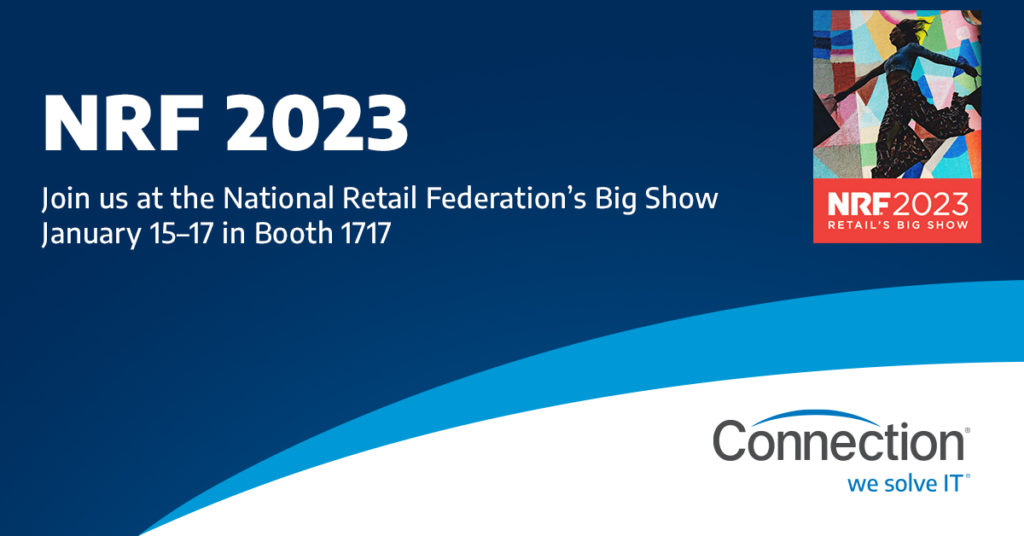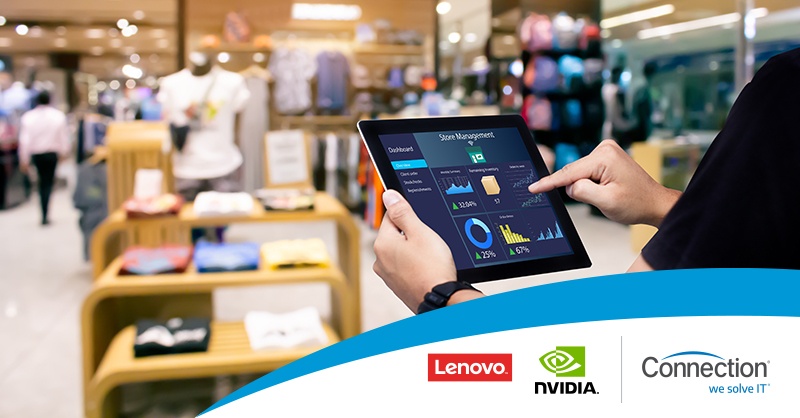Retailers can reduce shrinkage, diminish stockout, and enhance experiences for customers and employees with artificial Intelligence (AI). But that is just scratching the surface. AI-enabled intelligent stores can optimize so much more like managing staffing resources, reaching sustainability goals, and even predicting customers’ needs.
This podcast explores how AI solutions – a combination of data management, connectivity, edge computing devices, and software – can create powerful results. Experts from NVIDIA, Lenovo, and Connection cover real-world examples of how retailers are getting their return on investment and what strategies have been successful to reaching strong business outcomes.
Host: James Hilliard
Guests:
- Cynthia Countouris, Director of Product Marketing & Enablement for Retail, NVIDIA
- Matthew Bertucci, Retail Solutions Manager, Lenovo
- Brian Gallagher, Retail Strategy Director, Connection
You can hear us on Apple Podcasts, Amazon Music, Spotify, Google Podcasts, or Podbean
Show Notes:
[0:58] Are retail employees worried about AI replacing them or is it seen as a helpful tool? Anything new is typically seen as a potential threat. AI can enhance productivity and let employees focus on meaningful activities such as helping customers rather than checking inventory in the aisles. Retailers can alleviate these fears by demonstrating how AI can help reduce redundant tasks and enhance employees’ productivity. Showcasing how AI can be leveraged in flagship stores and providing videos and documentation can alleviate concerns while demonstrating the value it can bring.
[7:25] How can technologies enhance productivity? Camera vision or computer vision can help drive action by sending alerts or display information on digital signage. Integrating AI into these technologies can further automate and optimize the employee experience. For instance, AI can help advance the process of restocking inventory on shelves rather than having employees physically roam the aisles. Another example is streamlining the checkout process by displaying the estimated wait time for each line so customers can gauge which line to wait in. This also eliminates the need for an employee to moderate the lines or running the risk of one employee being inundated and another that isn’t.
[10:20] How can retailers make sure they can process data in real-time? First step is to understand the goals and what information is essential. Stockout doesn’t have to be in real-time, but loss prevention does. Retailers need to make sure they have the right edge compute power, technologies, and partners to develop the solution. Factors include volume of data points, analytics, and AI technologies as well as the size of the store and anticipated growth.
[12:25] What can retailers do to justify investments in AI? Kroger’s approach is a great example. NVIDIA and Lenovo worked with Kroger on their first foray into AI. To capture a quick return on investment, we focused on loss prevention and developed a proof of concept. It’s quicker to justify or recoup the investment by focusing on loss prevention. The concept was a success. From there, we used AI in other ways.
[13:40] Can you share more about how AI can help in loss prevention? Kroger found that a large portion of loss prevention was not intentional. For instance, customers accidently not scanning something at self-checkout. Having an AI-generated reminder on the screen is a much more comfortable experience rather than having an associate confront a customer.
[16:17] What about loss prevention as an internal issue? How can AI help here? It comes down to the approach. For instance, quick serve restaurants can set business rules on serving sizes. This can be reiterated through training. There are also opportunities for gamification by encouraging positive behaviors. Internal loss can be attributed to sustainability and making sure organizations are maximizing their resources and meeting goals by measuring waste and energy consumption. Internal loss could be related to spoiled products too. Kroger is exploring computer vision to monitor freshness of their products, for instance, automating when produce should be spritzed with water.
[21:30] How can AI help drive sales and promotion? AI lets businesses think in a non-linear fashion. And connecting AI with data analytics and camera vision enables customization at the store-level rather than a mass assumption of what will sell, when, and where.
[26:00] How can AI help with staffing plans? AI can be powerful by tracking or predicting needs based on upcoming events, weather changes, season, or time of day. It can also forecast products. AI can help connect customers to employees by alerting associates when someone is looking for something.
[29:43] Are most retailers’ infrastructure ready for AI? Infrastructure upgrades is typically needed. AI requires a substantial amount of internet connectivity. Retailers also need to have the capability to secure and protect all the edge points. This is where partners can come together to help provide the roadmap to implementing AI.
[31:57] Are there AI use cases that other retailers could turn to for ideas? Early adopters of AI include mass merchants, quick serve restaurants, and grocery stores. Many of them started small by identifying opportunities that have a clear ROI and an easy way to measure outcomes. Once there’s proof, use this experience as a steppingstone to think about AI in a broader way.
[36:50] What are some real-world savings retailers are seeing with AI? Shrinkage is a $100 billion problem for retailers. Addressing even a 30% decrease would result in huge savings. Mid-market retailers can likely see a return on investment on hardware costs within three months. It’s a clear win. Stockout is a 4% loss for retailers which can be recouped with AI.

Visit Connection’s booth at NRF 2023 or learn more about AI at www.connection.com/Smartstore.

